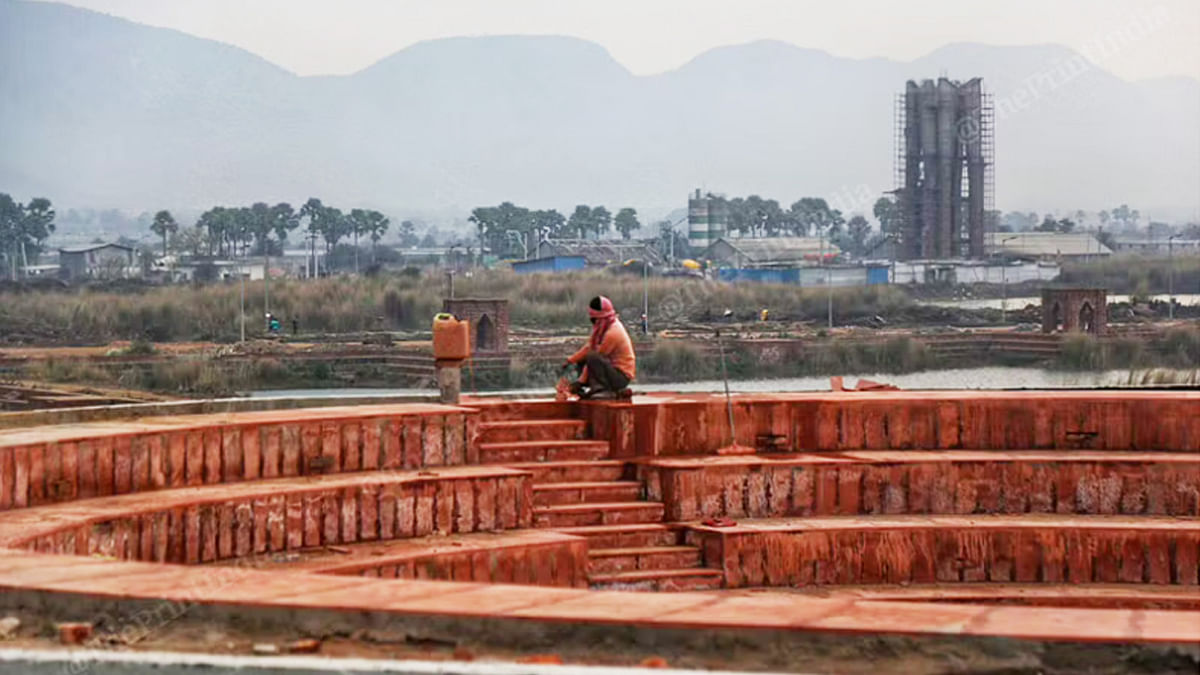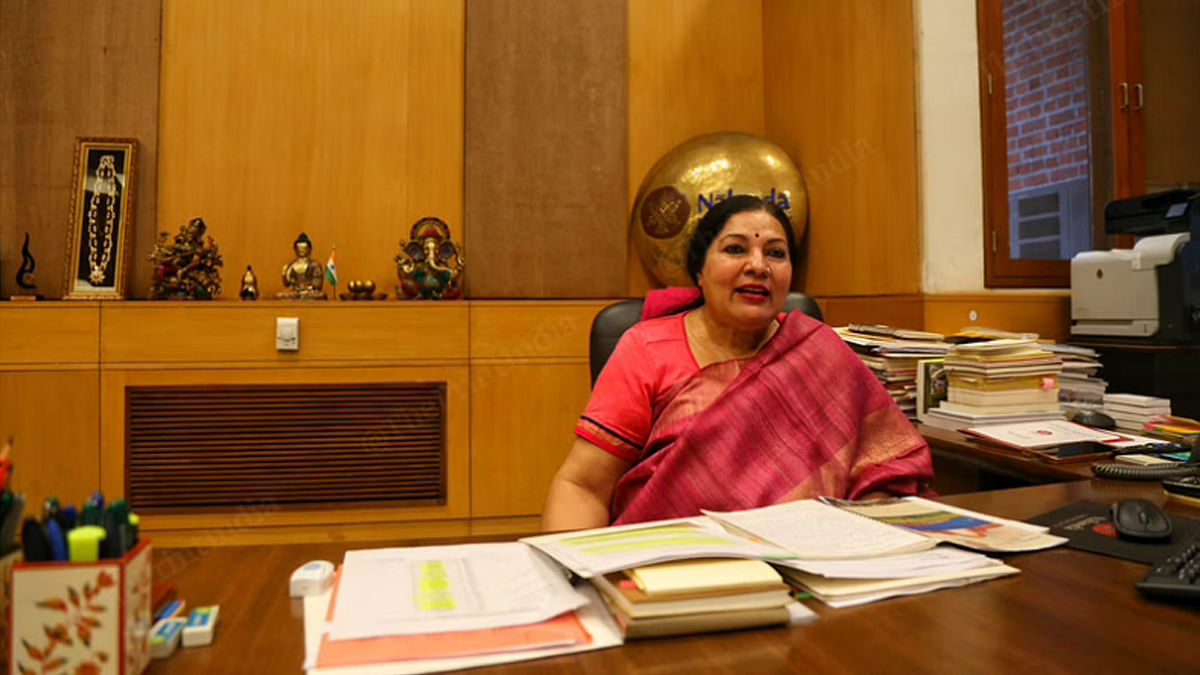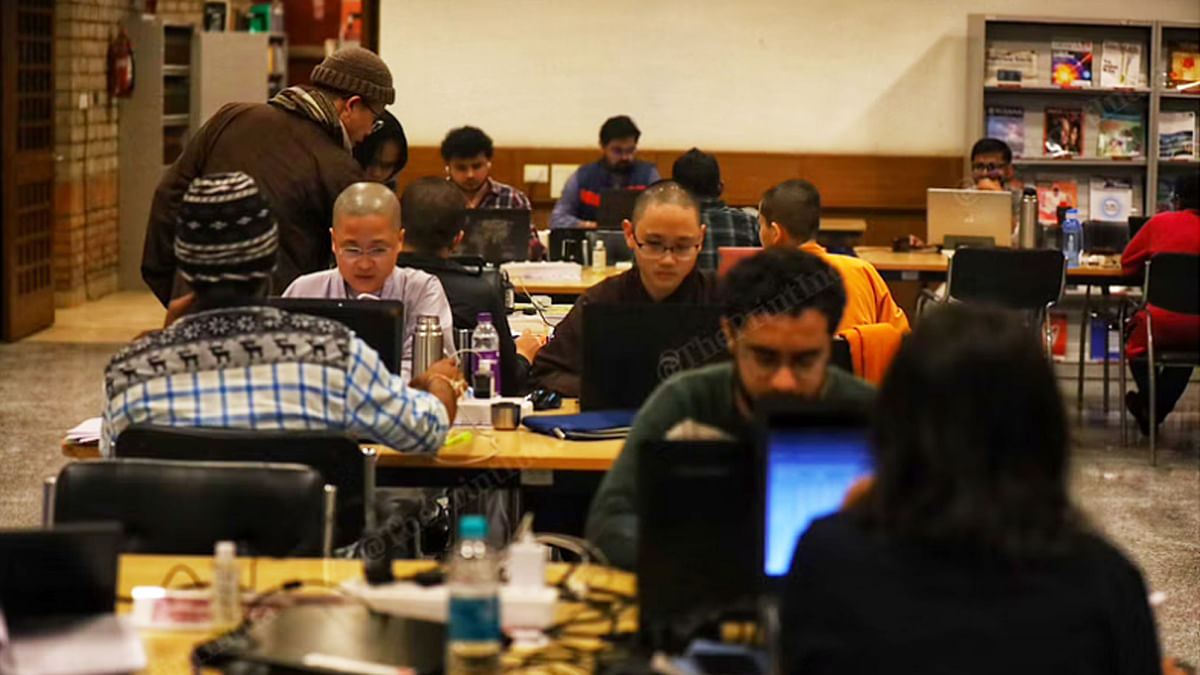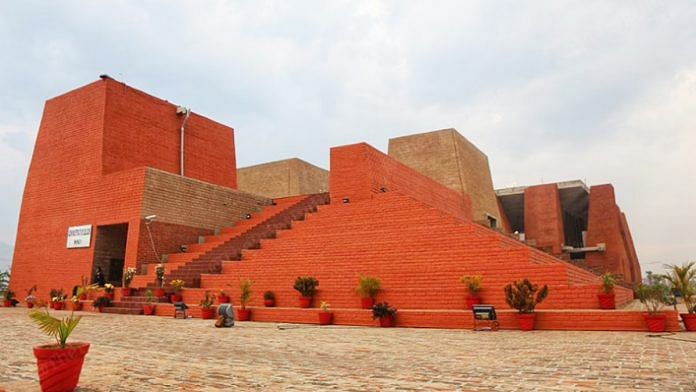Rajgir: A student from Myanmar performs a traditional candlelight dance against a backdrop, displayed on a giant screen, of paddy fields stretching to the horizon.
Another group of traditionally attired students — from Bhutan — chants hymns, with an image of the famous Taksang Monastery in Paro projected in the background. A group of Indian students glides through to the tunes of a Hindi song.
The performances were to celebrate India’s 75th year of Independence in Nalanda University — which draws its heritage from Nalanda, the ancient seat of learning.
Displaying the international character at the heart of the university, students of various nationalities came together at the auditorium on 25 February to celebrate ‘Azadi ka Amrit Mahotsav’, a central government programme to commemorate this landmark with a series of events throughout the year.
Like its ancient version — a Buddhist university renowned across Asia that was active 15 centuries back — Nalanda University was envisioned as an international campus that connects students from South and Southeast Asian countries.
The decision to revive the seat of learning in ancient Magadha was originally started in 2010, through an act of Parliament, when the foundation was laid.
After teething troubles, the first batch of students, numbering just 12, was admitted in 2014.
In the early years, the university operated from a campus in Delhi, then from a makeshift campus in Rajgir, Bihar, before finally starting operations from its new campus in 2019.
According to the official records of the university, the number of students, Indian and international, has reached 500 currently. Nalanda University now offers several academic programmes out of six schools.
Also read: The farce of university rankings and ‘liberal’ education in foreign countries
Early controversies
While the university has now picked up pace in terms of both its infrastructure and academic work, the state of affairs in the beginning had drawn criticism.
In 2007, three years before the university was launched, a mentor group was formed, with economist and Nobel laureate Amartya Sen as chair, to guide its formation.
The group consisted of former Singapore foreign minister George Yeo, academic Gopa Sabharwal, economist and former civil servant N.K. Singh, economist Meghnad Desai, Thai academic Prapod Assavavirulhakarn, historian Wang Gungwu of Singapore, Japanese scholar Susumu Nakanishi, Peking University professor Wang Bangwei, Tansen Sen of the City University of New York, historian Sugata Bose, and then secretary (east) of the Ministry of External Affairs, Preeti Saran.
The group functioned as the governing body from 2010 to 2016, after being given several extensions. It was dissolved in November 2016 by the then President of India, Pranab Mukherjee, creating resentment among some of the members.
Meghnad Desai told ThePrint over email, “Nalanda was meant to be changed from the Amartya Sen vision, which is why we were all replaced.”
There was a controversy about Amartya Sen’s alleged salary as well.
In 2015, BJP MP Subramanian Swamy claimed that Sen received an annual salary of Rs 50 lakh as the university’s chancellor. To this, the university later responded that Sen received “no salary whatsoever from Nalanda University”.
The same year, Sen, critical of the Modi government, opted out of a second term as chancellor of the university, alleging delay in approval for the tenure. The Ministry of External Affairs (MEA), however, denied the claim, saying there was “no attempt to curtail Dr Sen’s term”.
Two years later, there were reports that students were quitting courses midway because they did not get the promised academic experience at the university.
However, N.K. Singh, former revenue secretary and chairperson of the 15th Finance Commission, does not agree that the university had shifted from its original vision.
“I think the vision of the university and the original conception, acting as a bridge for students in different parts of Southeast Asia, remains the overarching objective,” Singh told ThePrint.
“There have been changes at the administrative level, but the vision has remained the same. Also, in today’s times, the importance of the university is a lot more pronounced, as it can act as a soft power for diplomacy,” he added.
With a brand new campus, Nalanda University Vice-Chancellor Sunaina Singh and the teaching staff hope to move past controversies, and towards academic excellence.
New campus modelled after the original Nalanda
Last month, the university administration shared a glimpse of the newly constructed campus with the outside world.
According to the data provided by the university, the construction of the main campus was scaled up — where 0.28 per cent was completed in 2017, over 80 per cent had been executed by 2021.
The sprawling 443-acre campus now comprises nearly 200 structures, including an amphitheatre, meditation hall, academic blocks, and the administrative block.

When one enters the campus, the first thing that strikes you is the similarity of the buildings being built with the imposing, extant structures of the historical Nalanda University, which now lies in ruins 10 km away from the current campus in Rajgir.
The older university campus, now called the Nalanda ruins, is a UNESCO world heritage site and a tourist attraction that used to draw nearly 2,000 to 4,000 visitors a day before the pandemic.
At Nalanda University, the past breathes life into the present, and the thematic design of the old Nalanda has been kept in mind while designing the architecture of the new university — this includes two huge water bodies, the famous brick design, thick walls and high ceilings.
The location, too, is one inextricably linked with early Indian history — surrounded by the Rajgir hills, the campus is an exquisite sight.
The gate of the campus announces the name of the new university: Nalanda University, written atop the gate in white, stark against a blue and red background that also boasts of the institution’s logo.
Inside, the campus stretches as far as eyes can see — the campus is so massive, one needs a vehicle to get about.
The first building on the campus is the administrative block, which overlooks a lake. A Tricolour adorns the building.
After a two-kilometre drive from the admin building, you see the teaching block and auditorium. Classes in the teaching block have been constructed with open spaces on either side — an attempt to facilitate discussions during class breaks.
While the administrative block, teaching block, faculty building and auditorium are some of the buildings that are ready and in use, other structures are still in the final stages of completion.
These include a recreational area and commercial complex, coming up by the side of the second lake on campus.
The amphitheatre is huge, with a staircase running down the depth of a well. The entire structure is brick-coloured, making it look like a reincarnation of the older Nalanda.
There are prayer and meditation rooms on the campus with massive open spaces in front of the second water body.
The new campus has been designed by architect Rajeev Kathpalia and his team at Vastushilpa Consultants. The team studied the design of the Nalanda ruins to build the architecture map of the new campus, which in time will have recreational facilities, a shopping complex, and accommodation for faculty and students.
According to the history section of the official Nalanda University website, “It (the original university) was a completely residential university believed to have 2,000 teachers and 10,000 students.”
“It attracted scholars from China, Korea, Japan, Tibet, Mongolia, Turkey, Sri Lanka, and Southeast Asia. These scholars have left records about the ambience, architecture, and learning at this unique university,” it says.
The most detailed accounts, the section adds, “have come from Chinese scholars and the best known of these is Xuan Zang, who carried back many hundred scriptures, which were later translated into Chinese”.
“When I came here in 2017, my first task was to examine what has been done so far and what can be done from here on,” Vice-Chancellor Sunaina Singh told ThePrint.

Most of the work on the new campus has been completed after the new V-C took charge. And she is also the only faculty member to stay on campus.
“In line with the ancient Nalanda tradition, the university has to be a residential campus. All students and faculty members are supposed to stay on the campus. I wanted to lead by example and hence I have already started living on the campus… I am expecting the faculty residences to be ready soon so that others can also come and stay.”
For now, students and faculty members are living in a makeshift hostel in Rajgir town, about 3 km from the campus. A shuttle service takes them to and from the university.
Courses at Nalanda University
Nalanda University started with two master’s courses — one in ‘Ecology and Environment’ and another in ‘Historical Studies’.
It currently has six schools.
The School of Buddhist Studies, Philosophy and Comparative Religion offers master’s and PhD programmes in Buddhist Studies, Philosophy, and Comparative Religions and a master’s programme in Sanātana Hindu Studies.
The School of Ecology and Environment Studies and School of Historical Studies both offer master’s programmes.
The School of Languages and Literature/Humanities offers master’s courses in world literature and short-term programmes in Korean, Sanskrit, English, Pali and Tibetan.
The School of Management Studies offers an MBA in Sustainable Development and Management. Lastly, there is the School of International Relations.
Three centres — Centre for Bay of Bengal Studies, Common Archival Resource Centre, and Centre for Conflict Resolution and Peace Studies — are also a part of the university.
The university has also started a ‘Global PhD’ programme. According to the information shared by the V-C’s office, some of the topics on which research students currently enrolled in the Global PhD programme are working are ‘historical study of the image of woman in Buddhism’, ‘the hidden gems of Drukpa Kagyu lineage’ and ‘Mahavira (s) of early India (8th-9th Century CE)’.
Talking about the courses currently being offered at the university, V-C Singh said, “When I took over as V-C, my first task was to examine what is there, what is not and what needs to be done. I reviewed whatever was done so far, looked at policies and documents and realised that we needed to multiply our courses.”
She added, “I would say all our courses are flagship programmes. The university is unique in that students from any discipline can apply… we do not restrict students from any background in pursuing what they want.”
“I am very mindful of what we are doing, I get academic audits of all courses and see their relevance. I want to be sure that we are a university of the future and all our courses are relevant,” she said.
Currently, Singh said, there are nearly 200 international students enrolled at Nalanda University from 31 countries, including from Bangladesh, Bhutan, Cambodia, Colombia, Indonesia, Laos, Malaysia, Nepal, Peru, Sri Lanka, Thailand, Singapore, Vietnam, and Mexico, among others.
The V-C said that, apart from Buddhist and historical studies, there is a lot of interest among students for the MBA in Sustainable Development and Management.
“Most students are in the Buddhist Studies and Hindu Studies programmes… the cultural ethos attracts students towards the university,” she added.
The university is also planning to start undergraduate courses from a campus in Neemrana, Rajasthan.
ThePrint caught up with students on campus — some of whom were busy rehearsing for the Azadi ka Amrit Mahotsav celebration while others were taking a break from academic work at the library.

Most of the international students ThePrint spoke to said they came to Nalanda because of a keen interest in history and culture.
Anusha from Thailand came to the university to pursue his passion for history after completing his bachelor’s in business management. He is currently pursuing a master’s in Historical Studies.
“I always wanted to come to India to learn about my own religion, Buddhism. Everything related to Buddhism happened here… the sites are not so far, I can go and visit the places and learn from the spot,” he said.
Another master’s student of Historical Studies from Bhutan said that she was from a small country, and Nalanda University had given her a lot of “exposure”.
“Initially, there were problems in adjusting, but now I like it here. I have learnt and grown here… not only did I learn from my own course, but also life skills and other cultures. And today we are celebrating 75 years of India’s freedom, so there is a lot of learning,” she added.
Mitali Dixit from Lucknow, UP, left her job in 2020 to pursue Historical Studies because she “always wanted to be a part of the university”.
“I was always interested in culture and history, which is why I came here. I learnt a lot of cultures here and interacted with students from various countries,” she told ThePrint.
While the international students ThePrint spoke to said they liked the academic environment, they added that adjusting to a new environment in terms of culture and food was a challenge.
Many students found it difficult to adjust to the more vegetable-based and less meat-based diet.
“We do get non-veg food, but the kind of meats that we eat, we do not get them here… so food was a problem initially, but we have adjusted to it now,” said a student from Bhutan.
According to Nalanda University officials, apart from the unique choice of courses, the fee structure also makes it a preferred choice for foreign students interested in a master’s degree.
The university’s official website says the fee for a master’s course for international students is $470/semester — about Rs 35,000.
For Indian students, the fee per semester is Rs 30,500.
Faculty members
The university currently has 47 faculty members, out of whom 17 are visiting lecturers.
According to V-C Sunaina Singh, attracting good faculty has been a challenge because of the location.
“It has been a challenge since I came here, because of the kind of infrastructure we have here. We are not a metropolitan city… there are no malls, cinema halls here… one just stays in the lap of nature,” she said.
“In order to overcome that, one of my goals has been to create good infrastructure. We give good housing to our faculty members… We should be able to overcome the challenges in another five years or so,” she added.
Former IAS officer Arvind Sharma, who teaches at McGill University in Montreal, Canada, is one of the international faculty members. He is also a part of the university’s governing board.
Other international faculty members include Prof. Antonino Raffone from Sapienza University of Rome, Italy, Yann-Pierre Montelle from Brown University, US, and Asanga Tilakaratne from the University of Colombo, Sri Lanka.
The university has Makarand Paranjape, director, Indian Institute of Advanced Studies, and Heeraman Tiwari, chairperson and professor, Centre for Historical Studies, Jawaharlal Nehru University, among others, in its academic council.
(Edited by Saikat Niyogi)
Also read: Studying engineering without physics and maths is like a building without foundation



